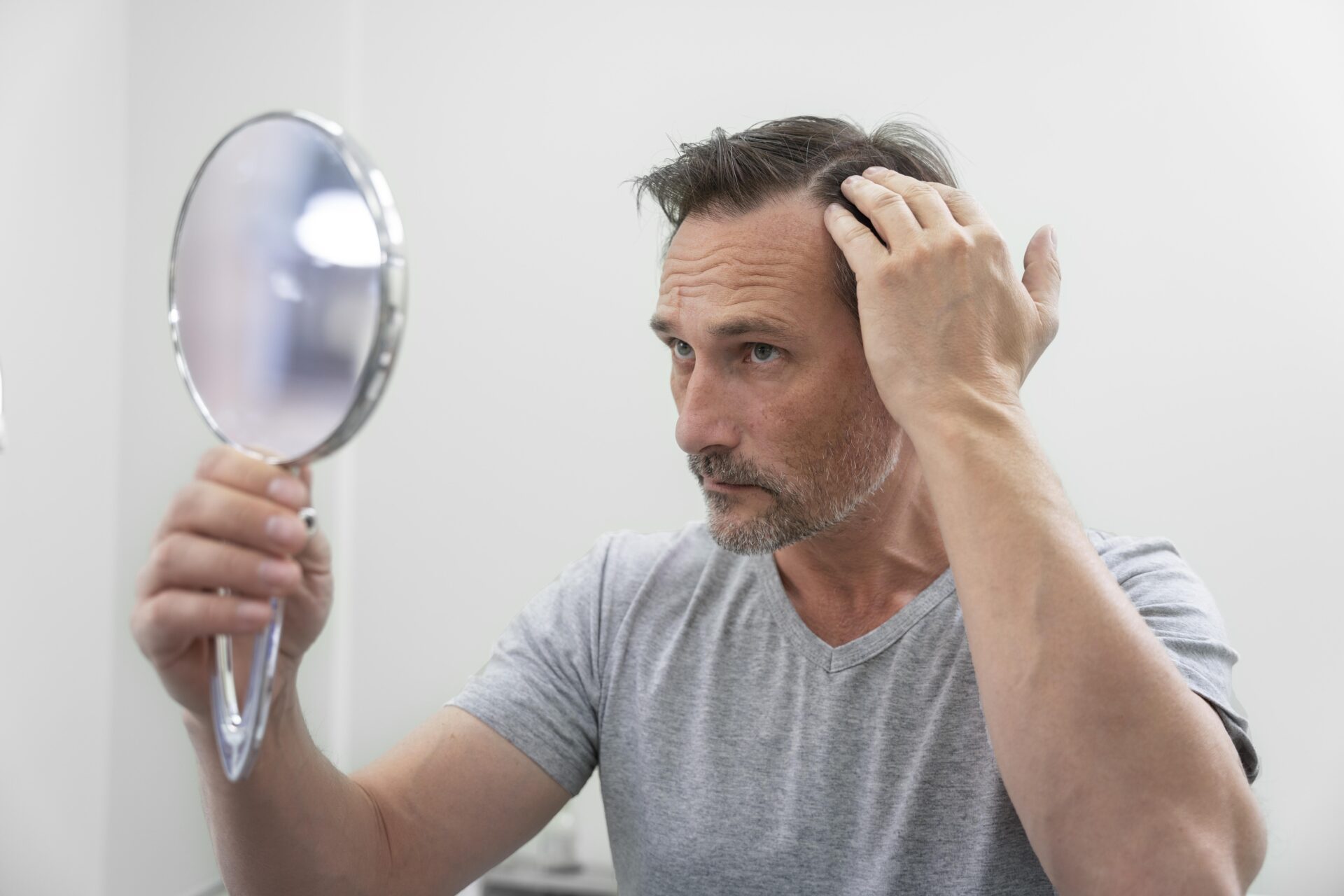
Introduction
Finasteride has long been considered a first-line treatment for androgenic alopecia, especially in men. It reduces dihydrotestosterone levels, slows miniaturization, and often increases hair density. But recent discussions within the medical and scientific community have raised concern: a growing number of studies are reporting an association between finasteride and psychiatric symptoms, including depression, anxiety, and suicidal ideation.
For many individuals, this creates confusion and fear—especially those already struggling with the emotional burden of hair loss. As a trichologist who integrates functional medicine, my goal is to provide clarity rooted in science, explain what these emerging findings really mean, and guide patients toward safer, more holistic pathways when appropriate.
How Finasteride Works in the Body
Finasteride is a 5-alpha reductase inhibitor, which means it blocks the enzyme that converts testosterone into dihydrotestosterone (DHT). Since DHT is the hormone responsible for shrinking genetically sensitive follicles, lowering DHT slows progression of androgenic alopecia.
What Finasteride Does Effectively:
- Reduces DHT by ~60–70%
- Slows hair miniaturization
- Increases hair count in many men
- Works best in early-to-moderate AGA
But It Also Alters Hormonal Pathways
DHT is not just a “hair-loss hormone.” It interacts with:
- Neurosteroids
- Cognitive pathways
- Libido and sexual function
- Motivation
- Mood regulation
Suppressing DHT can influence the central nervous system more than previously understood.
Mental Health Risks: What New Research Shows
Recent analyses of post-marketing surveillance and clinical studies point to a concerning pattern: some individuals experience psychiatric symptoms, particularly younger men. The symptoms reported include:
- Low mood and depression
- Anxiety
- Cognitive slowing (“brain fog”)
- Emotional blunting
- Suicidal thoughts
Why Are These Symptoms Appearing?
- Neurosteroid Disruption
Finasteride decreases levels of allopregnanolone—a neurosteroid that supports mood stability, stress resilience, and sleep. - Alteration of Androgen Signaling in the Brain
DHT plays a protective and regulatory role in the central nervous system. - Sexual Side Effects → Emotional Distress
Loss of libido, erectile dysfunction, or genital numbness can intensify anxiety or depression. - Younger men may be more susceptible
Research shows men under 40 appear to report psychiatric symptoms more frequently.
Importantly: not everyone experiences these effects.
But for those who do, the symptoms can be profound and persistent.
Who Is Most at Risk?
Emerging clinical patterns suggest caution in:
1. Individuals with a history of depression or anxiety
DHT and neurosteroid pathways interact with mood regulation. Vulnerable individuals may be more sensitive.
2. Those with hormonal imbalance
Low testosterone, low DHEA, adrenal dysregulation, or thyroid dysfunction may worsen psychiatric symptoms.
3. Individuals with metabolic or inflammatory stress
Inflammation affects neurotransmitters, steroid hormones, and brain function.
4. Men with high stress loads
Chronic cortisol elevation already destabilizes mood and sleep.
5. Individuals with genetic sensitivity
Variants in androgen receptors or neurosteroid pathways may predispose someone to adverse reactions.
Why This Matters for Hair Loss Patients
Hair loss is already emotionally challenging. Many clients feel defeated, fearful of aging, or distressed when hair density changes rapidly. Adding a medication with potential mood-altering effects can complicate the picture.
In my practice, clients thrive when:
- They feel informed
- Their treatment plan supports whole-body health
- Scalp and internal healing work together
- They understand the risks and benefits
- They have alternatives that feel safe
This is where functional trichology can offer a more comprehensive path.
A Functional Trichology Perspective
Finasteride can be appropriate—but only within a larger, integrative context. In functional trichology, we evaluate internal dysfunctions that contribute to hair loss:
1. Blood Sugar and Metabolic Stress
Impaired glucose control accelerates follicular inflammation.
2. Nutrient Deficiencies
Low zinc, B vitamins, amino acids, ferritin, or vitamin D affect keratin production and immune balance.
3. Gut and Liver Dysfunction
Poor detoxification leads to hormonal imbalance and inflammatory scalp environments.
4. Microbiome & Biofilm Activity
Biofilms on the scalp can impair penetration of treatments and worsen inflammation.
5. Thyroid and Adrenal Markers
These hormonal axes are essential for follicle cycling and recovery.
6. Immune Dysregulation
Chronic infections, autoimmunity, or high neutrophils/low lymphocytes often appear in hair loss patients.
Finasteride addresses one pathway—hormones.
Functional trichology addresses every system affecting the follicle.
Safer Alternatives and Adjuncts to Finasteride
For many individuals, a non-pharmaceutical or hybrid plan works better:
Internal Interventions
- Functional blood chemistry analysis
- Anti-inflammatory diet
- Liver support and gentle detoxification
- Zinc, omega-3, vitamin D, amino acids
- Blood sugar stabilization
- Gut microbiome optimization
- Stress reduction and sleep normalization
- DHT modulation through saw palmetto, nettle root, pumpkin seed oil (case-based)
Scalp Interventions
- Biofilm removal
- pH balancing
- Oxygenation and ozone therapy
- Microneedling
- Low-level laser therapy
- Essential oils (thyme, oregano, clove, tea tree)
- Cellular regeneration protocol
Epigenetic Hair Testing
For clients who prefer not to use medication—or when labs are unclear—epigenetic testing reveals nutrient patterns, gut stress, inflammation, amino acid deficiencies, and environmental triggers influencing hair loss.
When Finasteride Can Be Appropriate
Some patients genuinely benefit from finasteride, especially in these cases:
- Rapid AGA progression
- Strong family history
- Young men with early thinning
- Patients who prefer pharmaceutical support
- Patients combining medication with holistic care
Even then, safety requires:
- Monitoring mood monthly
- Tracking libido, energy, motivation
- Rechecking labs
- Supporting liver and gut function
- Integrating internal + external trichology care
The goal is informed, monitored, empowered choice—not fear.
Conclusion
Finasteride is neither a miracle nor a monster. It is a medication with a specific mechanism that can help many individuals when used safely and with proper guidance. The recent mental health concerns are real and deserve attention—but they do not mean the medication is universally harmful.
Functional trichology offers a broader, safer approach by strengthening the internal pathways that drive hair health. Whether someone chooses medication, a holistic protocol, or a combination of both, the best outcomes always come from addressing the root cause and supporting the body as a whole.
References
Ganzer, C. A., Jacobs, A. R., & Iqbal, F. (2015). Persistent sexual, emotional, and cognitive impairment post-finasteride: A survey of men reporting symptoms. American Journal of Men’s Health, 9(3), 222–228.
Irwig, M. S. (2012). Depressive symptoms and suicidal thoughts among former users of finasteride with persistent sexual side effects. Journal of Clinical Psychiatry, 73(9), 1220–1223.
Welch, J. L., & Gavino, A. C. (2022). Neuropsychiatric adverse effects of 5-alpha reductase inhibitors: A systematic review. Dermatologic Therapy, 35(1), e15176.
Melcangi, R. C., Santi, D., Spezzano, R., et al. (2017). Neuroactive steroid levels and psychiatric and andrological features in post-finasteride patients. Journal of Steroid Biochemistry and Molecular Biology, 171, 229–235.
Traish, A. M. (2020). The post-finasteride syndrome: Clinical manifestation of drug-induced androgen deficiency. Current Sexual Health Reports, 12, 55–74.

